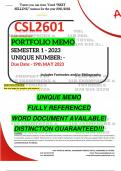Tutors you can trust. Voted “BEST
SELLING” memos for the year 2021/2022.
CSL2601
Constitutional Law
PORTFOLIO MEMO
SEMESTER 1 - 2023
UNIQUE NUMBER: -
Due Date: - 19th MAY 2023
Includes Footnotes and/or Bibliography
QUESTION PREVIEW
See next page for question and answers…
UNIQUE MEMO
FULLY REFERENCED
WORD DOCUMENT AVAILABLE!
DISTINCTION GUARANTEED!!!
Disclaimer
Extreme care has been used by our Tutors to draft this document, however the contents are provided “as is” without any representations
or warranties, express or implied. This document is to be used for comparison, research and reference purposes ONLY. No part of this
document may be reproduced, resold or transmitted in any form or by any means without prior written permission from the Author. –
LLB EXAMPACKS & TUTORIALS.
PAST PAPERS & MEMOS, ASSIGNMENT MEMOS, NOTES, SUMMARIES & TUITONS.
Cell: 074 074 3729 Email: llbexampacks@gmail.com
Fax: 086 096 5452 www.llbexampacksandtutorials.co.za
, QUESTION 1
1.1 By way of examples and references to the appropriate Constitutional Law
authorities, briefly explain the meaning of counter-majoritarian dilemma. (16)
The relationship between a supreme constitution and the court's testing power is that
when a constitution is supreme, ALL law and ALL conduct must comply with it and if it
does not comply, it MUST be declared invalid. We, the South African people, chose to
give our courts this testing power when our representatives drafted the Interim and Final
Constitutions in the early 1990s and provisions were included such as section 172 which
obliges the courts to declare law invalid. Accordingly, the testing power of the courts
reinforces the supremacy of the Constitution and ensures that it remains supreme and
that all laws are compatible with it.
The case of De Lange v Smuts NO is very important for our understanding of the unique
and special form that the separation of powers doctrine takes in South Africa. What the
court held is as follows: … over time our courts will develop a distinctively South Africa n
model of separation of powers, one that fits the particular system of government provided
for in the Constitution and that reflects a delicate balancing, informed both by South
Africa’s history and its new dispensation, between the need, on the one hand, to control
government by separating powers and enforcing checks and balances, and, on the other,
to avoid diffusing power so completely that the government is unable to take timely
measure in the public interest. What this essentially means is that the Constitution itself
does not prescribe a specific, fixed form of the separation of powers doctrine. Instead,
each case must be assessed on its own merits and guidelines can be developed over
time as to the best method of ensuring that each of the 3 principal organs of state
(legislature, executive, judiciary) retain their particular areas of power and expertise, but
at the same time (as the counter majoritarian dilemma has taught us), the judiciary is
entitled and empowered to declare law or conduct invalid if it does not comply with the
Constitution. Essentially, the counter majoritarian dilemma is where 11 judges (that is the





